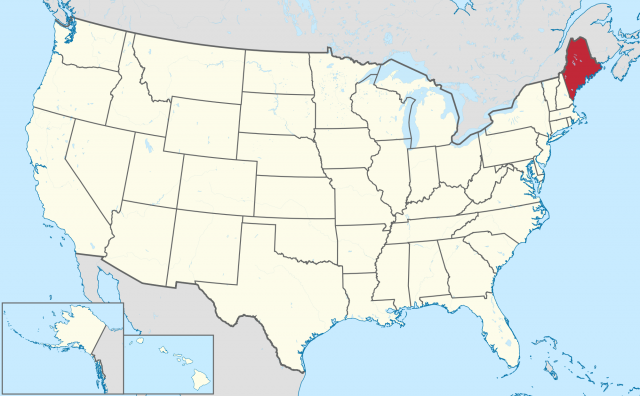Maine
MAINE IS THE easternmost state in the UNITED STATES and the northernmost of the 48 contiguous states. It is bounded to the east and south by the ATLANTIC OCEAN, to the northeast by the Canadian Province of New Brunswick, and to the northwest by the Canadian Province of Quebec. To the west, Maine is bordered by the U.S. state of NEW HAMPSHIRE.
Of the six New England states, Maine has by far the largest area, consisting of 33,215 square mi (86,026 square km). The state's famous rocky coast was shaped by glacial activity more than 12,000 years ago. The receding glaciers left behind thousands of islands, bays, and coves, resulting in 3,500 mi (5,632 km) of shoreline. For all its size, Maine has a low population density—there are only 1.3 million inhabitants, most of whom are concentrated in the south. Portland is the largest city, with a population of 64,000. Augusta is the capital. Other major urban areas include Bangor and Lewiston.

Maine is called the Pine Tree State. In its interior are 17 million acres (6.8 million hectares) of forest. While much of the northern forest areas are privately owned, there are many protected areas scattered throughout the state. Among them, Acadia National Park is a popular tourist destination. Other major recreational areas include the Allagash Wilderness Waterway and Baxter State Park.
Most visitors to the state enjoy the sandy beaches along the southern coast, between Kittery and Portland. Inland, there are approximately 6,000 lakes and ponds, and there are rugged, mountainous areas to the west. Of note, Moosehead Lake is the largest body of water wholly contained by any state, and Mt. Katahdin (the northern terminus of the Appalachian Trail), at 5,268 ft (1,605 m), is the state's highest peak. Maine typically sees short summers (with warmer weather along the southern beaches and cooler weather inland) and cold winters. The beach season typically starts in July and runs through early September.
The more remote, undeveloped areas of the state include the “Downeast” region along the upper shore in Washington County. The largely rural Aroostook County lies in the far north of the state. Maine was first settled as early as 3000 B.C.E., although little is known about these first inhabitants. Later, Native American tribes settled there, included the Micmacs, Abnakis, Passamaquoddies, and Penobscots. The first Europeans to explore Maine's coast may have been the Norse Vikings, in the 11th century; later, in the 1490s, Englishman John Cabot may have visited, although neither claim has been proven. Throughout the 1500s, English and French ships visited briefly, and in 1607, a group of English tried, and failed, to establish a colony. Permanent settlers did not arrive until the 1620s.
There is no consensus on the origin of the state's name, which first appeared in 1622. It is commonly believed that the name was used to refer to the mainland, distinguishing it from the numerous islands along the coast. The area later became part of the Massachusetts Bay Colony. Throughout the 1700s, area settlers experienced near continuous warfare, with both the native inhabitants and with the French. Because of its long coastline, Maine suffered from British sea attacks during the Revolutionary War. After the war, Mainers began to clamor for statehood, which was not realized until March 15, 1820, when Maine became the 23rd state as part of the Missouri Compromise—a Congressional policy aimed at preserving the balance between slave and free states. As part of that agreement, Maine was admitted to the Union as a free state, and Missouri as a slave state a year later. A strong abolitionist movement sprang up in Maine during the 19th century, and the state sent thousands of young men to fight in the Civil War. The state enacted prohibition laws in 1846 that lasted until the end of national Prohibition in 1934.
Maine's top agricultural commodities are potatoes, dairy products, eggs, seafood, and blueberries. The state is renowned as a source of fresh lobster, yielding 57 million pounds (25 million kg) of these saltwater crustaceans in 2000. In recent years, the state has experienced losses in its traditional base of manufacturing jobs. Tourism is now the primary industry, driven by an increasing number of visitors to the state's quaint coastal villages, rugged coastal headlands, and inland recreational areas. Because of their relative isolation and distance from the rest of the nation, Mainers (sometimes called “Mainiacs”) have staked out a reputation as a self-reliant, traditional people.